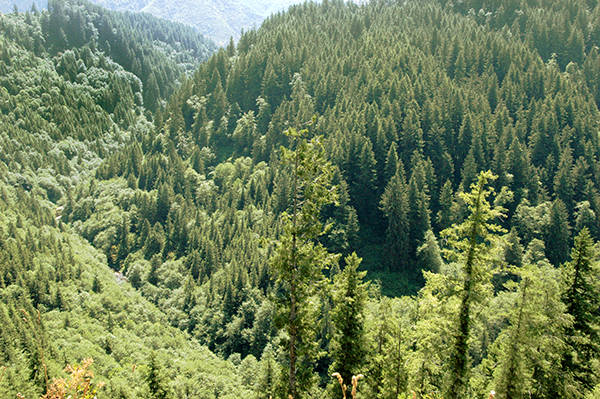 |
Source: oregonforests.org
For centuries, people have been drawn to Oregon by its beautiful scenery, natural abundance and, especially, its forests. As more and more people arrived, these forests gave way to towns, cities and highways. But through a modern dedication to sustainability, Oregon retains nearly 92 percent of the forest that covered the state in 1850. This is a testament to the commitment Oregonians made to the long-term survival of our forests and the important resources they provide. Now climate change threatens our way of life. |
For most of us, we live in the Pacific Northwest because of the deep green forests, the snow capped peaks, the rivers and streams, the entire ambiance of the outdoor life. . . even if you rarely head out to the forest, peaks, rivers and streams.
Vegetation is projected to change from predominantly conifer as shown above to predominantly mixed conifer and hardwood forests, according to modeling results in a study published in the journal PLOS ONE.
Much of the current forests can be expected to eventually be replaced by trees better adapted to future conditions which would reduce timber available for harvest. An increase in hardwoods could result in a decline of mature evergreen trees for harvest, according to the study authors. Projected impacts on forests could affect fresh water supplies, wildlife habitat quality, and recreation. It is reasonable to anticipate that climate-driven stress will make these forests more susceptible to disease and pests, the authors wrote.
"The bottom line is that forests on the western side of Oregon and Washington will be under a lot of stress in the future," said the study's lead author, Tim Sheehan, a doctoral student at OSU. "Our findings point out the seriousness of climate change and the importance of working to limit climate change as much as we can, as well as to look at the region and identify those areas that are either more or least susceptible to climate change, to better target management activities."
For all scenarios, the dominant vegetation type shifts from pure conifer to mixed forest, indicating that vegetation cover change is driven solely by climate and that likely mortality and vegetation shifts are expected to occur through the 21st century regardless of the change in fire regime, Sheehan said.
"The fact that the vegetation changes so much over a short period of time points to the possibility that we won't be able to get a cycle of mature vegetation throughout the region over the next 100 years," he said.
As members of the Portland Tourism Industry, we need to be aware of these forecasts and if true, how they might effect our lives and businesses. Having a captive audience on a tour gives each of us a chance to mention how the climate is changing, and what we each can do to bring about change.
* * * * *
Story Source: Tim Sheehan, Dominique Bachelet, Ken Ferschweiler. Fire, CO2, and climate effects on modeled vegetation and carbon dynamics in western Oregon and Washington. PLOS ONE, 2019
Comments
Post a Comment